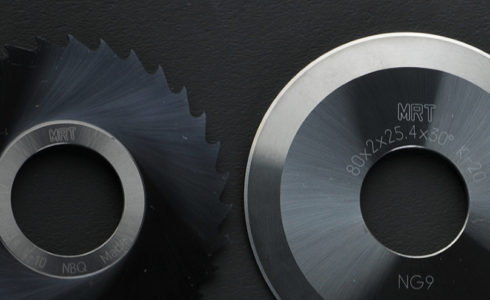Cutting conditions
Cutting condition
First, please enter the specs which you are using, the number of rotations, etc. and calculate the speed of cutting. After that, please compare it with the standards which MRT recommends(please refer to the following chart)
※The speed which MRT recommends is just a standard. It varies from the type of work materials and the performance of the machines. If you would like further informationt in detail, please contact our technical staff.
Please confirm the work material or cutting materials, and try to compare to the table below.
◆Cutting speed V(m/mim)
| Work Material | Cutting materials | ||||
|---|---|---|---|---|---|
| Common material | High speed steel | Carbide | |||
| Iron steel | Carbon steel | Super soft steel | S10C | 30~60 | 60~130 |
| Soft steel | S30C | 40~60 | 80~130 | ||
| Semi-hard steel | S40C | 35~55 | 70~110 | ||
| Hard steel | S50C | 30~50 | 60~100 | ||
| Hardest steel | SK5 | 25~40 | 50~80 | ||
| Free cutting steel | Lead Free cutting steel | Additional code “L” | 45~70 | 100~150 | |
| Sulfur Free cutting steel | Additional code “S” or “SUM” | 50~80 | 110~170 | ||
| Stainless steel | Ferritic Stainless | SUS430 | 30~65 | 60~130 | |
| Martensitic Stainless | SUS420J2 | 20~55 | 50~120 | ||
| Austenitic Stainless | SUS304 | 15~50 | 40~110 | ||
| Special steel | High manganese steel | SCMnH21 | 5~15 | 15~30 | |
| High speed steel | SKH51 | 15~30 | 35~60 | ||
| Tool steel | SK2 | 20~30 | 60~90 | ||
| Alloy steel | SCM430 | 35~50 | 70~110 | ||
| Cast materials | Chilled cast iron | ― | 5~15 | ||
| Alloy cast iron | 5~15 | 15~35 | |||
| Spheroidal graphite cast iron | FCD50 | 15~35 | 35~60 | ||
| Standard cast iron | FC20 | 20~50 | 45~100 | ||
| Malleable cast iron | FCMB32 | 20~30 | 40~70 | ||
| Cast steel | SC46 | 25~40 | 50~80 | ||
| Non-ferrous metals | Copper alloy | Copper | C1100 | 40~100 | 80~250 |
| Bronze | BC2 | 70~100 | 150~250 | ||
| Brass | C2600 | 100~250 | 200~350 | ||
| Light alloy | Silicon aluminum alloy | AC3 | 25~40 | 50~80 | |
| Aluminum alloy | A2017 | 120~200 | 250~400 | ||
| Aluminum | A1100S | 150~400 | 300~500 | ||
| Magnesium alloy | MP1 | 200~600 | 400~1200 | ||
| Titanium | TR35 | 10~30 | 20~60 | ||
| Cobalt and Nickel alloy | Stellite | ― | 7~15 | ||
| Hastelloy X | ― | 10~20 | |||
| Inconel X | ― | 15~30 | |||
| Nickel | NNCP-0 | ― | 10~25 | ||
| Non-metals | Thermosetting plastic | 80~130 | 180~250 | ||
| Thermoplastic | 150~220 | 300~450 | |||
◆Feed per tooth Sz(mm/tooth)
| High speed steel screw slotting cutter | 0.01mm~0.04mm |
|---|---|
| Solid carbide metal slitting saw | 0.005mm~0.02mm |
Sz=Vf/Z・N
Vf:Feed speed(mm/min)
Z:Number of teeth
N:Cutting rotation per minute(r.p.m.)
Troubleshooting for cutting use
◆Deciding the cutting speed
Maintain low speed when....
- durability of the cutter is required
- the work material is hard, or it is coated with surfaces resistant to wear
- the processing is in a primary stage (coarse cutting)
- the process is new or still unfamiliar for you
- the wear and the damage of cutting edge are rapid
Maintain high speed when....
- the work material is relatively easy to be cut
- finishing process which requires high precision and accuracy
◆Choosing the feed per tooth
Decrease the feed when....
- the work material can only be set up in an unstable position, or you are handling a thin and irregularly-shaped material
- the work material must be cut by a thin, fragile cutter
- the machined surface must be high level accuracy of roughness
- chipping occurs more than minimum feed condition
- you are slotting a deep groove
Increase the feed when....
- the work material set up firmly, heavy duty cutting
- the work material is relatively easy to be cut, or it is hard only on the surface, and the inside is relatively soft
- the work material surface has intermittence shape
- relief angle of the cutter wears rapidly
- the machinery vibration occurs at cutting process
If you must change the machine set up from the testing stage, please experiment with the cutting speed, feed, depth, independently to find out what causes right / wrong results.
Even if the combination is proven right during the testing stage, it is advisable to gradually increase the limit to reach the highest efficiency possible. Then, adjust the limit to meet the safety guidelines for the best result.
Please reinforce with fix ture equipment if necessary.





